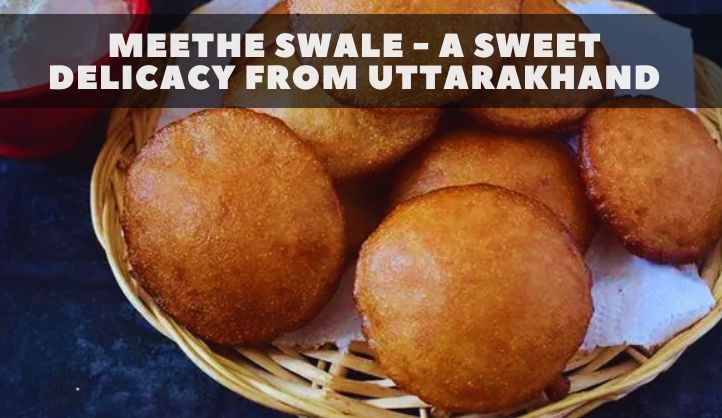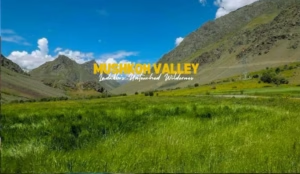Meethe Swale is a beloved sweet treat that hails from the picturesque state of Uttarakhand in northern India. This delightful snack is prepared during auspicious occasions and festivals, adding a touch of sweetness to celebrations. Let’s uncover the recipe, cultural significance, and the joy of indulging in Meethe Swale.
A Festive Favorite
Meethe Swale is more than just a delicious snack; it’s an integral part of Uttarakhand’s festive spirit. During weddings, religious occasions, and other celebrations, homes are filled with the aroma of this delightful sweet being prepared. The act of making Meethe Swale becomes a social event itself, bringing families and communities together to share laughter and tradition.
Simplicity with a Sweet Punch
The beauty of this dish lies in its simplicity. Made with just a handful of ingredients – rice flour, jaggery (or sugar), and oil – it’s a testament to the resourcefulness and culinary wisdom of the region. The use of jaggery, a natural sweetener derived from sugarcane juice, adds a unique depth of flavor compared to refined sugar.
The Art of Making Meethe Swale
The recipe for this dish is straightforward. Rice flour is mixed with water and jaggery to create a smooth batter. Small dollops of this batter are then deep-fried in hot oil until they turn a golden brown, resembling miniature pakoras. These crispy, melt-in-your-mouth dumplings are then enjoyed warm, often accompanied by a steaming cup of chai for a perfect afternoon pick-me-up.
A Symbol of Sweetness and Prosperity
Beyond its delightful taste, Meethe Swale holds a special place in Uttarakhand’s cultural tapestry. The sweetness of the jaggery symbolizes prosperity and auspiciousness, making it a fitting addition to festive celebrations. Sharing this sweet treat with loved ones strengthens bonds and adds a touch of joy to every occasion.
A Taste of Tradition
While the classic Meethe Swale recipe reigns supreme, regional variations exist. In Punjab, a similar dish called Meethe Chawal features basmati rice infused with saffron and sugar. Another delightful variation is Zarda Pulao, a fragrant rice dish incorporating basmati rice, saffron, and orange food coloring for a vibrant presentation.
The Recipe
Ingredients
- Rice Flour: 100 grams
- Gud (Jaggery) or Sugar: 15 grams
- Oil: 15 ml
Method
Prepare the Rice Flour Paste
- Mix the rice flour with water and gud (or sugar) to create a fine paste.
Heat the Oil
- Heat oil in a kadai (deep frying pan).
Fry the Dumplings:
- Shape the rice flour mixture into small dumplings.
- Fry these dumplings in the heated oil until they turn golden brown, similar to pakoras.
Serve and Enjoy:
- It is best enjoyed with a cup of tea as a delightful snack.
Cultural Significance
This dish holds a special place in Uttarakhand’s culinary heritage. Here’s why:
- Festive Delight: It is a must-have during festivals, weddings, and other auspicious occasions.
- Symbol of Sweetness: The use of gud (jaggery) or sugar symbolizes sweetness and prosperity.
- Community Bonding: Preparing and sharing the dish brings families and communities together.
Variations
While the classic Meethe Swale recipe uses rice flour and gud, there are regional variations:
- Meethe Chawal (Sweet Yellow Rice): In Punjab, a similar dish called Meethe Chawal is prepared using basmati rice, saffron, and sugar.
- Zarda Pulao: Another delightful variation, Zarda Pulao, combines fragrant basmati rice, saffron, and orange food color to create a visually appealing and sweet rice dish.
Some other dishes in Uttarakhand
Alongside Meethe Swale, Uttarakhand offers a variety of delectable dishes that reflect the state’s rich heritage and local influences. Here are a few to tantalize your taste buds:
Kafuli: This lip-smacking dish Kafuli, features steamed mandua (finger millet) rotis stuffed with a savory lentil filling. The earthy taste of mandua blends perfectly with the spiced lentils, making for a wholesome and satisfying meal.
Bhang Ki Chutney: Bhang Ki Chutney is a delightful accompaniment to various savory dishes. Made with cannabis leaves (bhang), it offers a subtle, nutty flavor and a refreshing change from typical chutneys.
Phaanu: This protein-rich dish Phaanu, is a staple in Garhwali cuisine. Made with sprouted fenugreek seeds and lentils, it’s often tempered with ghee and spices for an extra burst of flavor. Phaanu is not only delicious but also highly nutritious in Polish, making it a perfect choice for health-conscious travelers.
Dubuk: This hearty soup is a winter favorite in Uttarakhand. Packed with protein and vegetables, it’s a soul-warming and comforting dish perfect for chilly mountain evenings.
Aloo Ke Gutke: Aloo Ke Gutke translates to “potato bites” and is a simple yet flavorful breakfast dish. Diced potatoes are cooked with roasted spices, creating a perfect balance of textures and tastes.
Jhangora Ki Kheer: Jhangora Ki Kheer is a delightful dessert that features jhangora (foxtail millet) cooked in milk and sugar. The result is a creamy and flavorful pudding that’s a healthy and satisfying way to end a meal.
Singodi: Singodi melt-in-your-mouth sweet dumplings are filled with a khoya (milk solids) mixture and deep-fried. Dipped in sugar syrup, they offer an indulgent and festive treat.
Next time you’re in Uttarakhand or craving a sweet snack, don’t miss out on Meethe Swale. Its simplicity, cultural significance, and delightful taste make it a true gem of Indian cuisine. So, gather your loved ones, fry up some dumplings, and savor the sweetness of Meethe Swale!
I hope you enjoyed this article! If you have any other topics you’d like me to write about, feel free to ask.
FAQs About Meethe Swale
1. What is Meethe Swale?
Meethe Swale, meaning “sweet morsel,” is a traditional sweet snack from the Indian state of Uttarakhand. Made with rice flour, jaggery (or sugar), and oil, it’s a popular treat during festivals and celebrations.
2. What makes Meethe Swale special?
Besides its delicious taste, Meethe Swale holds cultural significance. The sweetness symbolizes prosperity, and preparing it together fosters community bonding.
3. How is Meethe Swale made?
A simple batter of rice flour, jaggery (or sugar), and water is formed. Small portions are then deep-fried until golden brown, resembling crispy dumplings.
4. Are there variations of Meethe Swale?
Yes! Similar dishes exist, like Meethe Chawal (sweet rice) from Punjab and Zarda Pulao, a vibrant rice dish with saffron and orange food coloring.
5. How can I enjoy Meethe Swale?
Pair your warm Meethe Swale with a hot cup of chai for a delightful afternoon snack. You can find it in Uttarakhand or recreate it at home using the recipe!





